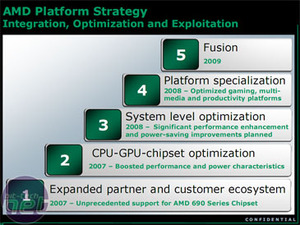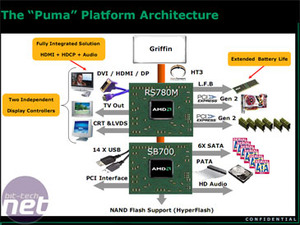Notebooks are due to overtake desktops as the primary PC at work and in the home by 2011. Their attractions include having a lower power draw and greater portability than desktops, and they're now starting to become as powerful as desktop machines, too. Intel has traditionally been a market leader in this sector with its Centrino platform and its ever popular Pentium M CPU, but now the tables may be set to change.
AMD competed with its Turion and later the Turion X2 processor but lacked the necessary co-ordination of chipset vendors for low profile, high specification units. Since the acquisition of ATI, this has made its complete platform solution much easier to attain in the short term, and long term we’re looking a complete integration of CPU and GPU with Fusion in 2009 and beyond.
Hot on the heels of Intel’s recent ‘Santa Rosa’ launch, AMD has today announced ‘Griffin’ as its new mobile CPU and ‘Puma’ the new platform supporting it. Before this, AMD made CPU architectures that scaled from top to bottom, from Server to Mobile.
Obviously the needs of a high power, high throughput server platform are very different than that of small, light, low power mobile one and AMD admits some compromises were previously made. However, it previously didn’t have the resources to go any other way. These compromises were made on the mobile platform as it was concentrating on desktop performance and servers when it introduced the Athlon 64 and Opteron.
In the same way that AMD has just announced Phenom only for its high end solutions, now it is building a completely independent mobile CPU, with a focus on combining power saving with performance in a whole system solution.
The platform still stops short of Intel’s requirement to use Intel wireless draft-802.11n, Gigabit Ethernet controllers and Intel TurboMemory controllers in its mobile platform, because AMD tells us that its partners enjoy freedom of diversify in their product designs to provide differentiation in the marketplace. That, and Intel provides a significant financial benefit for Centrino marketing which AMD can’t match.
Indeed, this should allow greater diversity, but it commonly boils down to using the cheapest solution available which does ultimately result in cheaper laptops, but also a largely variable mobile experience. Intel’s strength was that you know everything will work together perfectly and the computing experience will be relatively consistent whatever company you choose.
However, even for Intel this is no longer the case as the Santa Rosa specification appears to be more open than previous incarnations; just a CPU, chipset and wireless card can equal “a Santa Rosa laptop” now. It seems this may offer up a future of AMD and Intel on more equal footing (since Intel has just put a bullet through one of its own).
AMD competed with its Turion and later the Turion X2 processor but lacked the necessary co-ordination of chipset vendors for low profile, high specification units. Since the acquisition of ATI, this has made its complete platform solution much easier to attain in the short term, and long term we’re looking a complete integration of CPU and GPU with Fusion in 2009 and beyond.
Hot on the heels of Intel’s recent ‘Santa Rosa’ launch, AMD has today announced ‘Griffin’ as its new mobile CPU and ‘Puma’ the new platform supporting it. Before this, AMD made CPU architectures that scaled from top to bottom, from Server to Mobile.
Obviously the needs of a high power, high throughput server platform are very different than that of small, light, low power mobile one and AMD admits some compromises were previously made. However, it previously didn’t have the resources to go any other way. These compromises were made on the mobile platform as it was concentrating on desktop performance and servers when it introduced the Athlon 64 and Opteron.
In the same way that AMD has just announced Phenom only for its high end solutions, now it is building a completely independent mobile CPU, with a focus on combining power saving with performance in a whole system solution.
Puma: Power of the beast and lovable pussycat?
Whereas AMD has tiptoed into the ‘platform’ arena, providing catchy buzzwords like “Live!” but little else in the way of knowing exactly what you’re getting, now it is due to offer a complete platform solution with CPU, chipset and the option of a discrete graphics card for notebooks.The platform still stops short of Intel’s requirement to use Intel wireless draft-802.11n, Gigabit Ethernet controllers and Intel TurboMemory controllers in its mobile platform, because AMD tells us that its partners enjoy freedom of diversify in their product designs to provide differentiation in the marketplace. That, and Intel provides a significant financial benefit for Centrino marketing which AMD can’t match.
Indeed, this should allow greater diversity, but it commonly boils down to using the cheapest solution available which does ultimately result in cheaper laptops, but also a largely variable mobile experience. Intel’s strength was that you know everything will work together perfectly and the computing experience will be relatively consistent whatever company you choose.
However, even for Intel this is no longer the case as the Santa Rosa specification appears to be more open than previous incarnations; just a CPU, chipset and wireless card can equal “a Santa Rosa laptop” now. It seems this may offer up a future of AMD and Intel on more equal footing (since Intel has just put a bullet through one of its own).

MSI MPG Velox 100R Chassis Review
October 14 2021 | 15:04











Want to comment? Please log in.